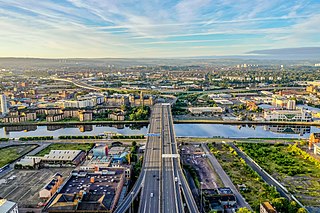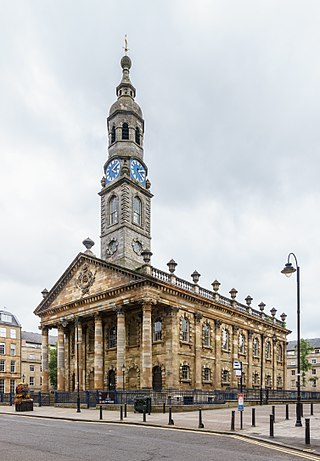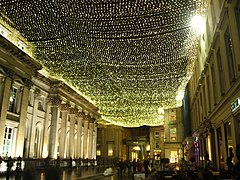
Glasgow is the most populous city in Scotland, located on the banks of the River Clyde in west central Scotland. The city is the third-most-populous city in the United Kingdom and the 27th-most-populous city in Europe. In 2020, it had an estimated population as a defined locality of 632,350 and anchored an urban settlement of 1,028,220.

Glasgow City Council is the local government authority for Glasgow City council area, Scotland. In its modern form it was created in 1996. Glasgow was formerly governed by a corporation, also known as the town council, from the granting of its first burgh charter in the 1170s until 1975. From 1975 until 1996 the city was governed by City of Glasgow District Council, a lower-tier authority within the Strathclyde region.

George Square is the principal civic square in the city of Glasgow, Scotland. It is one of six squares in the city centre, the others being Cathedral Square, St Andrew's Square, St Enoch Square, Royal Exchange Square, and Blythswood Square on Blythswood Hill.

Buchanan Street is one of the main shopping thoroughfares in Glasgow, the largest city in Scotland. It forms the central stretch of Glasgow's famous shopping district with a generally more upmarket range of shops than the neighbouring streets: Argyle Street, and Sauchiehall Street.

Townhead is a district within the city of Glasgow, Scotland. It is one of Glasgow's oldest areas, and contains two of its major surviving medieval landmarks – Glasgow Cathedral and the Provand's Lordship.
Garnethill is a predominantly residential area of the city of Glasgow, Scotland with a number of important public buildings.

The city of Glasgow, Scotland, has a transport system encompassing air, rail, road and an underground light metro line. Prior to 1962, the city was also served by trams. Commuters travelling into Glasgow from the neighbouring local authorities of North and South Lanarkshire, Renfrewshire, East Renfrewshire, and East and West Dunbartonshire have a major influence on travel patterns, with tens of thousands of residents commuting into the city each day. The most popular mode of transport in the city is the car, used by two-thirds of people for journeys around the city.

The St George's Tron Church, in Glasgow, Scotland, is a Church of Scotland church in the city centre, located in Nelson Mandela Place, previously known as St George's Place, fronting Buchanan Street at West George Street, along from Queen Street Station. It should not be confused with the 17th-century Tron Church, which lies to the south-west on Trongate and was redeveloped in the 1980s as the Tron Theatre. Located right on the busiest shopping street in Scotland, the building is a significant presence, and the oldest in the area. It stands as a terminating vista for West George Street.
Blythswood Hill, crowned by Blythswood Square, is an area of central Glasgow, Scotland. Its grid of streets extend from the length of the west side of Buchanan Street to Gordon Street and Bothwell Street, and to Charing Cross, Sauchiehall Street and Garnethill. Developed from 1800 onwards, its Georgian and Victorian architecture is a Conservation Area. It started as the "Magnificent New Town of Blythswood", becoming a part of the city-centre's business and social life.

Sauchiehall Street is one of the main shopping streets in the city centre of Glasgow, Scotland, along with Buchanan Street and Argyle Street.

Trongate is one of the oldest streets in the city of Glasgow, Scotland. Trongate begins at Glasgow Cross, where the steeple of the old Glasgow Tolbooth is situated, being the original centre of medieval Glasgow, and goes westward changing its name to Argyle Street at Glassford Street. In modern times, it forms the notional southern boundary of the Merchant City area.
Pride Scotia was Scotland's national community-based LGBT Pride festival alternating between the cities of Edinburgh and Glasgow, held in June from its beginnings in 1995 until 2008, when it split into separate organisations.

The International Financial Services District (IFSD) is a financial district in the city of Glasgow, the largest city in Scotland. Nicknamed "Wall Street on the Clyde", it ranked in the top 40 of international financial districts, ahead of cities including Brussels, Madrid, Helsinki, Milan and Dublin.

Glasgow Cross is at the hub of the ancient royal burgh and now city of Glasgow, Scotland, close to its first crossing over the River Clyde. It marks the notional boundary between the city centre and the East End
Glasgow City Centre is the central business district of Glasgow, Scotland. It is bordered by the Saltmarket, High Street and Castle Street to the east, the River Clyde to the south, and the M8 motorway to the west and north. It is made up of the areas of Garnethill, Blythswood Hill, and Merchant City, though parts of Cowcaddens, Townhead, Anderston and Calton also fall within its boundaries.

St Andrew's Square is a public square in the city of Glasgow, Scotland and lies to the south east corner of Glasgow Cross, close to Glasgow Green. The square is noted for its immense 18th-century classical church, St Andrew's in the Square, from which the square takes its name. The church was completed in 1758, to the designs of architect Allan Dreghorn and master mason Mungo Naismith and is among the finest of its type anywhere in Britain. The interior has lavish 18th century rococo plasterwork. The building is Category A listed. It is one of six squares in the city centre.

Blythswood Square is the Georgian square on Blythswood Hill in the heart of the City of Glasgow, Scotland. The square is part of the 'Magnificent New Town of Blythswood' built in the 1800s on the rising empty ground west of a very new Buchanan Street. These open grounds were part of the vast Lands of Blythswood stretching to the River Kelvin acquired by the Douglas-Campbell family in the 17th century. The Blythswood district, and its grid of streets, became a Conservation Area in 1970, because of its important architectural and historic buildings.

The Tron Church is an evangelical Presbyterian church which meets in three locations across Glasgow—in the city centre on Bath Street, in the Kelvingrove area of the West end of Glasgow, and on the Southside of Glasgow near Queen's Park.

Sandyford is an area of Glasgow, Scotland. It is north of the River Clyde and forms part of the western periphery of the city centre. Formerly the name of a ward under Glasgow Town Council in the first part of the 20th century, it is within a continuous area of fairly dense urban development bordering several other neighbourhoods whose mutual boundaries have blurred over time, and is possibly less well known than all of the places which adjoin it, particularly Anderston and Finnieston.

















